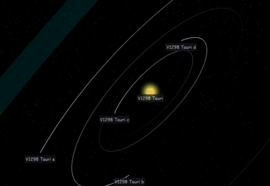V1298 Tauri is a young (23±4 Myr) weakly-lined T Tauri star[5] that is part of the Taurus-Auriga association in the Taurus Molecular Cloud. Alternatively it is part of a proposed moving group, called Group 29 that is slightly older.[6][7][3] The system has four transiting exoplanets, discovered with the Kepler space telescope in the K2 mission.[5] One of the planets was discovered in August 2019[3] and the other three were discovered in November 2019 by the same team.[5]
 The planetary system V1298 Tauri Credit: Exoplanet Exploration Program and the Jet Propulsion Laboratory for NASA’s Astrophysics Division | |
| Observation data Epoch J2000.0 Equinox J2000.0 | |
|---|---|
| Constellation | Taurus |
| Right ascension | 04h 05m 19.59121s[1] |
| Declination | +20° 09′ 25.5635″[1] |
| Apparent magnitude (V) | 10.31 - 10.43[2] |
| Characteristics | |
| Spectral type | K0-K1.5[3] |
| Variable type | Irregular[2] |
| Astrometry | |
| Proper motion (μ) | RA: 5.228 ± 0.131[1] mas/yr Dec.: -16.077 ± 0.048[1] mas/yr |
| Parallax (π) | 9.2139 ± 0.0593 mas[1] |
| Distance | 354 ± 2 ly (108.5 ± 0.7 pc) |
| Details | |
| Mass | 1.095+0.049 −0.047[4] M☉ |
| Radius | 1.33+0.04 −0.03[4] R☉ |
| Luminosity | 0.934 ± 0.044[3] L☉ |
| Temperature | 4970 ± 120[3] K |
| Rotation | 2.97+0.03 −0.04 d[4] |
| Age | 23 ± 4[3] Myr |
| Other designations | |
| Database references | |
| SIMBAD | data |
Stellar characteristics

V1298 Tauri has a spectral type of K0 - K1.5 and it has a mass of about 1.1 M☉. The star appears in x-rays from ROSAT data and it does show strong lithium absorption lines, both signatures of youth and therefore it was a proposed member of Taurus-Auriga. On the other hand it does not show signs of accretion and it lacks infrared excess. Instead it shows H-alpha in absorption.[3]
The brightness of V1298 Tauri varies in an unpredictable way between a maximum visual magnitude of 10.31 and a minimum of 10.54.[2] The light curve of the star shows quasi-periodic variability that was interpreted as stellar rotation and starspots. The light curve also showed several flares.[3]
Based on Gaia DR2 data this star is part of a co-moving pair, together with HD 284154.[6]
Planetary system
V1298 Tauri has four confirmed planets of which planets c, d and b are near a 1:2:3 resonance (with periods of 8.25, 12.40 and 24.14 days). Planet e only shows a single transit in the K2 light curve and has a period larger than 36 days. Planet e might be in a low-order resonance (of 2:3, 3:5, 1:2, or 1:3) with planet b. The system is very young and might be a precursor of a compact multiplanet system. The 2:3 resonance suggests that some close-in planets may either form in resonances or evolve into them on timescales of less than 10 Myr. The planets in the system have a size between Neptune and Saturn. Only planet b has a size similar to Jupiter.[5]
Models predict that the planets have a minimum core mass of 5 ME and are surrounded by a thick envelope that make up 20% of their mass. The total mass of planet c and d was predicted to be 2 - 28 ME and the total mass of planet d and b was predicted to be 9 - 120 ME.[5] In a follow-up paper the mass of V1298 Tauri b was constrained to <2.2 MJ.[8] The planet c was suspected to be shedding mass due to intense irradiation by the host star, but hydrogen tail existence was refuted by 2021.[9]
Orbits of the planets b and c are nearly coplanar and planet c is not inclined to the equatorial plane of the star, misalignment equals to 2+12
−4 degrees.[10]
| Companion (in order from star) | Mass | Semimajor axis (AU) | Orbital period (days) | Eccentricity | Inclination | Radius |
|---|---|---|---|---|---|---|
| c | — | 0.0825 ± 0.0013 | 8.24958 ± 0.00072 | <0.43 | 88.49+0.92 −0.72° | 0.499+0.032 −0.029 RJ |
| d | — | 0.1083 ± 0.0017 | 12.4032 ± 0.0015 | <0.21 | 89.04+0.65 −0.73° | 0.572+0.040 −0.035 RJ |
| b | <2.2 MJ | 0.1688 ± 0.0026 | 24.1396 ± 0.0018 | <0.29 | 89.00+0.46 −0.24° | 0.916+0.052 −0.047 RJ |
| e | — | 0.308+0.182 −0.066 | 50.29±6.62[11] | <0.57 | 89.40+0.26 −0.18° | 0.89±0.04[11] RJ |
See also
- List of nearby stellar associations and moving groups
- List of exoplanets discovered in 2019
- Kepler-223 - the first confirmed system with four exoplanets in resonance
- K2-138 - a system with five exoplanets in a 3:2 resonance chain